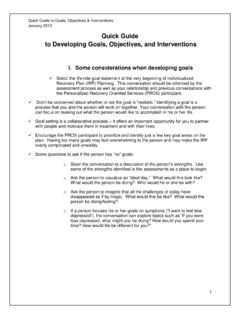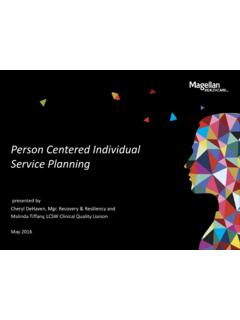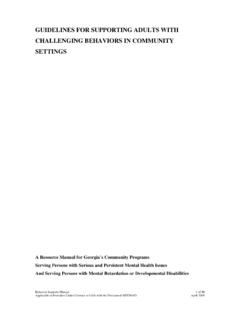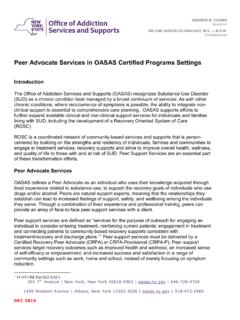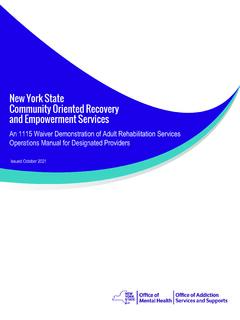Transcription of Patient-Centered Case Management Assessment & Patient ...
1 Patient - centered case Management Assessment & Patient interview TechniquesRose M. Turner, RN, BSN, ACMT hursday, January 8th, 2015 The information provided in AHC Media Webinars does not, and is not intended to constitute medical or legal advice. Opinions, references and links provided by our speakers are provided for your convenience and do not represent our endorsement of such opinions, products or M. Turner, RN, BSN, ACM, is President of Rose M. Turner Consulting, a hospital case Management consulting firm where she uses over 20 years of expertise to design programs that are Patient focused and easy to operationalize. She has worked in hospital case Management for over 20 years managing the most complex cases on the front lines and designing programs and processes for difficult Patient populations as a special projects case manager.
2 Her hospital work also includes developing policy, astute knowledge of government regulations affecting case Management , and implementing case Management education & orientation the unique elements of the case Manager s clinical a framework for assessing the long-term needs of the hospital how to provide a safe discharge based on the CM new and revised case Management standards, regulations, and laws put forth by CMS, TJC and the federal case Management protocols and Overview The clinical Assessment for discharge planning includes a combination of: Clinical information from the chart Socio-economic information from the Patient Support systems in place Prior physical & cognitive function Knowledge of clinical outcomes for Patient s diagnosisUnique stories Each Patient story presents it s own unique set of variables All the elements must be considered to develop the best plan for each particular Patient There is no cookie cutter approach What is a great plan for one Patient may be totally wrong for anotherIt s all about the Patient The Patient is the most important person in the story Each Patient is a unique individual no two stories alike Discharge planning must be tailored to meet the
3 Individual Patient s needs It s OK for the Patient to make a bad decision We must support whatever they decide to doThe Nurse as an Advocate We stand for the Patient We honor their wishes We treat every Patient with respect and dignity We protect their benefits We include them in the decision making We work with the other disciplines to provide the best plan for the patientStart at the beginning of the Chart review ED reports/H&P What brought them to the hospital? Fall? Clinical symptoms? Nurses notes Dirty? clothes filthy? evidence of skin breakdown? Check labs anemia? INR off the chart? Dig toxic? What you need to find in the What is the medical diagnosis or condition now?
4 What are the implications of the disease process? How long are they expected to be in the hospital? What would be the needs at discharge? Does the Patient have the resources to cope with this diagnosis? In what setting?Found in the History & Physical Medical history Info on long term chronic illness Current problems Previous medical dx give clues to Patient s experience with rehab/equipment already at home Social history Support structure Medications How many? Too many? Anti depressants? High use of pain meds? In the rest of the Review labs, radiology reports Reveals course of tx, discharge needs Watch trends in labs Review therapy notes Gives information on functional level Bedside nursing notes O2 sats/eating 50% of trays or route of nutrition?
5 /orthostatic hypotension?The interview the other part of the Assessment Verifies the information in the chart review Have an idea of what type of discharge plan would be best before you enter Neverexclude the Patient Address your remarks to the Patient even if the family member will be making the decisions and the cognitive ability of the Patient is in question Always keep in mind how you would wish to be treated in this situationThe Patient interview To collect information Add to the information collected from the chart Does it all make sense? How cognitive is the Patient to make decisions? Allow the Patient to be part of the decision making process Patient /family buy-in to change Be direct, be honestInterview Skills Knock on the door (even if it is open) Ask permission for their time Respect privacy come back if visiting (unless Patient indicates it s OK) Solve comfort issues first to have their attention (pain med/blanket/repositioned)
6 Sit at eye level maintain eye contact Lean in Use touch Take a face sheet to keep yourself oriented and for notes Avoid taking a great deal of notes or appearing to engrossed in documentation Focus on the Patient Include the Patient in the discharge planning process Active listening Offering options Education Pull in family and friends if allowed Accept limitations Work with what you have Allow bad decisionsBuild a Rapport You must be viewed as a trustworthy partner Be direct and clear in your communications Avoid medical jargon The Patient /family will appreciate clarity even if the news is not good Keep your wordActive Listening Be prepared to listen to the story Not every complaint/venting requires a solution Find common ground Respect the life they have lived Sympathy vs.
7 Empathy Throw out the stereotypesTypes of questions Direct demand specific answers Do you live in a one story or two story? How many steps at home? Do you have any equipment at home? Open-ended So, you live alone. How s that working out? How do you do your shopping? Are you getting pat answers? Can they stay on topic? Can they problem solve? Can they verbalize your recommendations, rephrase your answers? ( patients with dementia will answer in the same word pattern)The answers you will Can they problem solve? Listen carefully. Don t interrupt. Pay attention. What else is going on? Does the information add up? Does the information you are getting jive with the chart information?
8 Offering Options Changing one s home can be frightening There is always more than one solution Be willing to change the plan to meet the needs of the Patient Accept their alternatives Allow their ownership of the planEducation Working with the Patient /family on the discharge plan provides education opportunities About their health benefits About community resources About limitations The Village Will a Patient allow the village in? Every adult is legally responsible for their own finances and obligations Adult children are not responsible Work with what you have Let the Patient direct which family/friends to involveAccepting Limitations For who? You or the Patient ?
9 Allowing patients to make bad decisions Document their statements in quotes Can you accept the limitations that the Patient has to live with? Even community resources can fail you Living in the real worldElements of your Assessment Prior level of functioning Support systems Resources both financial & community Current functional ability Needs for a safe discharge to maximize full recovery Patient /family acceptance of the planDocumentation of your Assessment Document as soon as possible after the interview It s easy to forget which details go with which Patient Go back with information (OK to say I don t know. ) Ask for more information if needed from interdisciplinary team members (can PT try the Patient on stairs?)
10 Follow the CMS regulatory guidelines for documentationNew Guidelines from CMS 42 CRF Conditions of Participation Discharge Planning Standards Identification of patients in need of discharge planning Discharge planning evaluation Discharge plan Transfer or referral Reassessment Each one of the detailed standards covers the basics of good discharge planning Nothing new in this regulation just puts good discharge planning in the regulations Applies to Inpatients not to patients in other areas (OP or ED)Develop a tool to identify patients that need a plan (a)Standard: Identification of patients in need of discharge hospital must identify at an early stage of hospitalization all patients who are likely to suffer adverse health consequences upon discharge if there is no adequate discharge planning.




